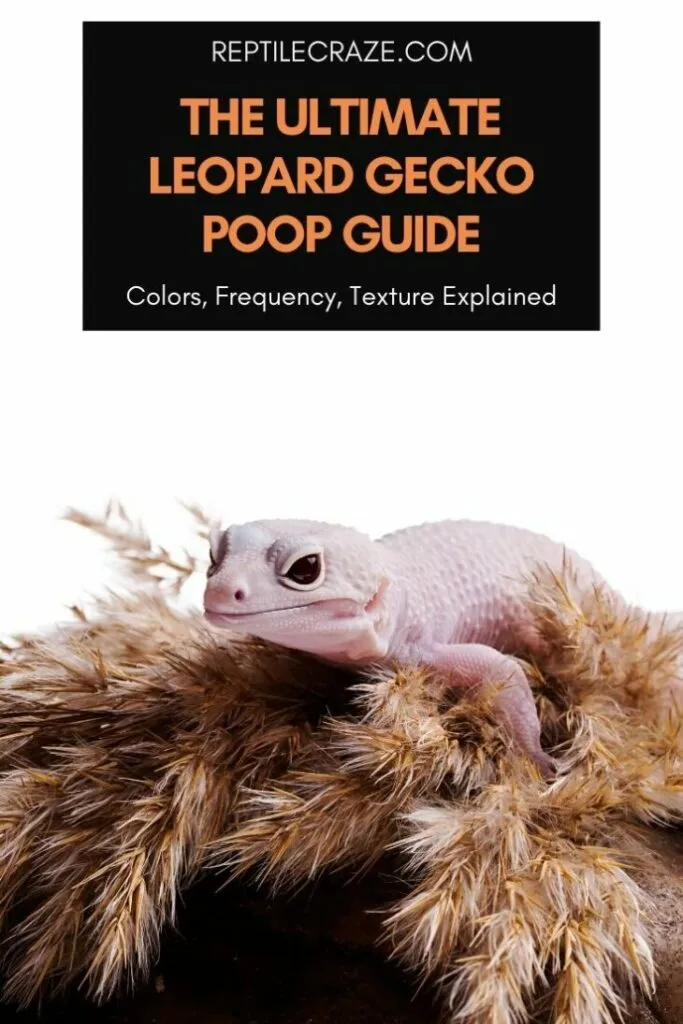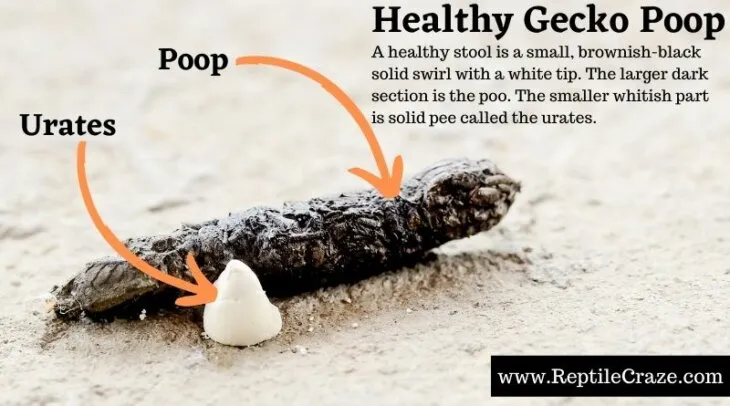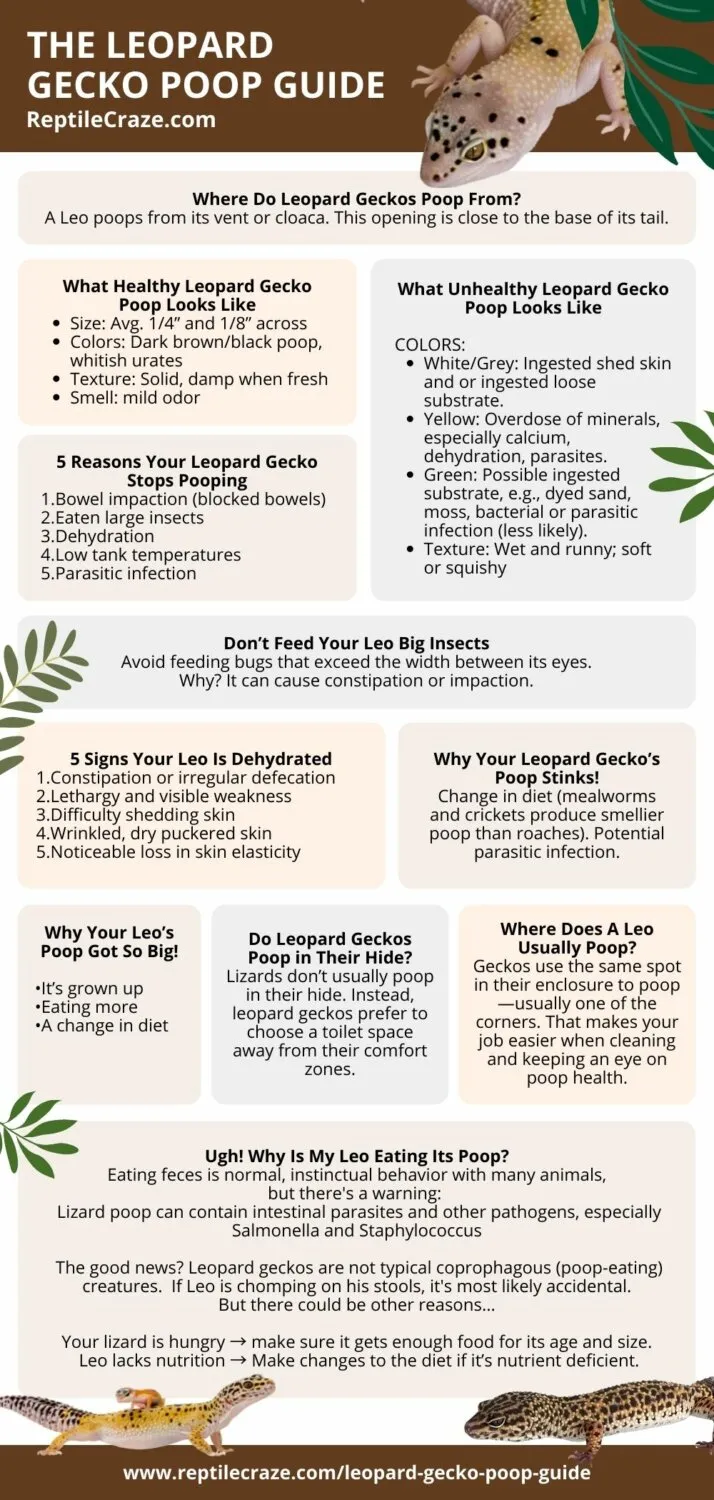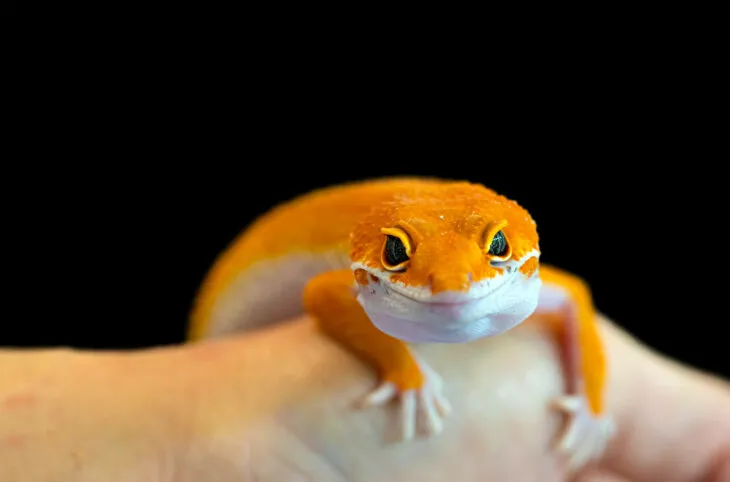
All living creatures defecate, and your leopard gecko is no exception. But not all feces is equal, and the lessons you can learn from your lizard’s poop may surprise you.
A leopard gecko’s poop is a good indicator of its overall condition. The bottom half of a healthy stool is typically solid, dark brown to black, with a separate white or off-white top section. The fresh excrement has a mild smell that’s barely detectible to humans. Any other colors, consistency, or odors could suggest health issues.
This easy-to-follow guide explains all you need to know about leopard Gecko’s poop. You’ll learn how to tell healthy feces from unhealthy and the likely causes of any changes. We also look at what action to take to correct a distressed digestive system.
The Leopard Gecko’s Poop Chart
This chart summarizes probable causes for changes to leopard gecko poop.
| Poop Concerns | Possible Causes |
|---|---|
| Not pooping | Lost appetite (other health issues), dehydration, incorrect |
| Undigested insects in feces | Overdose of vitamins, below average |
| Whitish poo | Feeding on shed skin or ingested loose substrate. |
| Green | Possible ingested substrate, e.g., dyed sand, moss, bacterial or parasitic infection (less likely). |
| Yellow color | Overdose of minerals, especially excess calcium, dehydration, parasites. |
| Grey color | Feeding on shed skin, ingested loose substrate. |
| Watery or smeared stool | Diarrhea caused by worms, parasites, stress, and or viral infections, unsanitary enclosure. |
| Worms | Possible parasitic infection, fly maggots. |
We’ll get to the details of these poop concerns soon, but first, let us show you what healthy leopard gecko feces look like.
The Leo Owner’s Guide to Healthy Poop
The best way to spot unhealthy Leo poop is to know what normal looks like.
A healthy stool is a small, brownish-black solid swirl with a white tip. The larger dark section is the poo. The smaller whitish part is solid pee called the urates (see image above).
The urates consist of tiny solid chunks made up of uric acid and superfluous chemicals. Sometimes, there can be a little liquid pee around the feces, too.

Healthy Poop Texture
Fresh leopard gecko poop is well-formed and solid yet soft. A slightly runny stool is not usually any cause for concern. Still, keep an eye on your reptile’s toilet area to see if things get worse.
The attached urate is about one-third the size of the poop and has a dry, chalky texture. The average size is 1/4” long and 1/8” across but can be bigger.
The only worry is if your gecko’s stool is noticeably soft, watery, or an unusual color. The following sections look at these poop variations in more detail.
What Do the 5 Colors of Leo Poop Tell You?
There are five colors of poop to recognize, and four of those may suggest a problem with your pet’s digestive system.
These are often no cause for concern if you’re on top of good husbandry practices and your reptile lives in a healthy environment. Also, adult leopard geckos don’t poop every day, so remember to check the toilet area regularly.
OK, let’s look at these color variations and what action—if any—you need to take.
Fun fact: Hatchling and juvenile leopard geckos will often poop several times a day. But the adults usually only go once every few days when fed a healthy diet.
#1 Why Is Your Leopard Gecko’s Poop White?
White poop is not the thing as the white-colored urate, which is perfectly normal. Here, we’re talking about white or whitish poop—or poop bits—mixed in with the darker stool.
Often, the white excrement is shed skin that your reptile consumes. However, it could also be light-colored substrates like sand or paper towels.
Substrate in poop?
Inexperienced gecko owners often panic and remove any loose substrate from the enclosure, especially artificial material. But there’s a reason your gecko ingests substrate, and removing it may be unnecessary.
We look at a more natural solution to this problem later in the section on bowel impaction.
#2 Why Is Your Leo’s Poop Milky Grey?
You may come across various shades of lighter grey poop. The causes are the same as the whiter stools, i.e., feeding on shed skin or ingesting loose substrate.
#3 Black Leopard Gecko Poop
Black poop is more likely to be a very dark brown on closer inspection and is nothing to worry about. Feces can be many shades, from medium to dark brown and close to black.
The differences are down to what you feed your pet and the amount of bile in its stool. As bile travels along the digestive system, chemical changes make it dark.
#4 Yellow Poop (Urate and Stool)
A yellow urate could be the result of too many vitamins or calcium. Check the dosage for the gecko’s age and size. A less likely cause is a parasitic infection. In most cases, though, dehydration is the main reason behind a yellow urate.
How to rehydrate your leopard gecko.
Even human pee goes darker yellow when we’re dehydrated, and the fix is to hydrate. It’s a good idea to recheck your gecko’s enclosure.
Make sure the lizard has access to fresh water daily and moisture. It’s also worth reevaluating your reptile’s diet.
Yellow mucus in a Leo’s stool.
There’s something wrong if your Leopard Gecko’s stool has yellowish mucus. It could be inflammation caused by parasites, infection, or dehydration. Get your reptile checked by a vet if there’s still a problem the next time it poops.
Did You Know: Leopard gecko’s digestion relies on heat (warmth from the ground and from above). If the enclosure is too cold, it can affect the reptile’s ability to digest
food .
#5 Why Is Your Leopard Gecko’s Poop Green?
One reason for green poop is that your Leo has ingested some loose substrate. The usual culprits are dyed sand, moss, or paper roll. If the feces are also runny, it could be the gecko’s digestion adapting to a change in diet.
Diarrhea is often greenish, too, but we’ll get into the possible causes and cures for that shortly, but first, here is a little infographic with quick facts we designed for you.

Poop Textures & Toilet Routines Matter
There’s more to learn about your Leo’s metabolic waste outside the color chart. After all, this is the ultimate leopard gecko poop guide, right.
So the rest of this page ZOOMS IN on toilet habits, feces consistency, and potential health issues that can affect both.
Why Is My Leopard Gecko’s Poop Watery?
A runny, watery, or overly squishy stool and frequent pooping is not normal and suggests diarrhea. It’s even more of a problem if the feces contain undigested insects.
The typical culprits are worms and parasites, usually gotten from
Here are the 6 signs of potential leopard gecko diarrhea:
- Loose watery-like feces
- Frequent passing
- Foul-smelling poop
- Noticeable fatigue
- Sudden loss of appetite
- Dehydration
Good gecko husbandry is the best way to help avert diarrhea. If it’s too late, take your pet and a sample of its feces to your local vet asap. They can prevent or treat any dehydration and start your sick Leo on systemic medications.
Poop sample tip: Put the gecko’s poop into a small plastic container or a Ziploc bag. If you can’t make it to the vets right away, refrigerate (not freeze) the sample.
If you don’t have an exotic vet in your area, you should book an online vet. We highly recommend doing so at Vetster. They have awesome service, it is easy to use, and they offer 24/7 appointments. Check out Vetster here!
How Often Should Leopard Geckos Defecate?
How often your leopard gecko uses the toilet depends on its size, age, metabolism, and diet. However, there are general guidelines to what’s normal and what’s not.
Young Vs. Older Leopard Geckos
Healthy hatchlings and juvenile leopard geckos defecate a few times daily. The full-grown adults, though, tend to only go to the toilet once every few days. Use this size and growth chart if you’re not sure of the age of your leopard gecko.
| Age | Weight | Length (snout to vent) | Poop Frequency |
|---|---|---|---|
| Hatchling | 0.07–0.17 oz. (2–5g) | 3 “–4” (7.62–10.16 cm) | 1–5 times per day |
| 1 month | 0.5–0.7 oz. (15-20g) | 4″ (10.16 cm) | 1–3+ times |
| 2 months | 0.6–1.05 oz. (18-30g) | 5″ (12.7 cm) | 1+ times |
| 6–18 months | 0.8–2.1 oz. (25-60g) | 3″–6″ (12.7–15.24 cm) | Once per day |
| 18+ months | 1.41–2.8 oz. (40-80g) | 8″–11″ (20.3–28 cm) | Every 2–3+ days |
What to Do When Your Leopard Gecko STOPS Pooping
Caring pet owners should be mindful of their leopard gecko’s toilet habits. That means regularly examining its stools and toilet frequency. If you notice a sudden stop in bowel movement, then it’s time to look for the cause(s).
Here are the 5 main reasons a leopard gecko stops pooping:
- Bowel impaction
- Eaten overly large insects
- Dehydration
- Low
tank temperatures - Parasitic infection
Let’s look at the causes and possible solutions for each of these issues. Also, if you want to learn more about why your leopard gecko isn’t pooping in detail, click here to read our guide on that.
Leopard Geckos Impaction Issues
Your leopard gecko can stop pooping when it suffers from impaction. Sadly, it’s an all too common issue, especially with less experienced owners. It’s also one of the easiest to fix once you find the root cause of the problem.
What is bowel impaction—exactly?
Bowel impaction occurs when indigestible material or a fecal mass forms and blocks the lizard’s tiny bowels. It’s a potentially fatal condition if left untreated. That’s because it can cause the gecko’s digestive system to collapse, resulting in organ failure.
Causes of bowel impaction.
Any loose substrate in your pet’s habitat can cause bowel impaction. Typical examples are paper towels, wood chips, and sand. Your gecko most likely eats substrate to make up for the lack of essential minerals.
They do this in the wild by ingesting dirt. But your pet doesn’t know the substrate in its enclosure is not mineral-based soil.
A loose substrate is not usually a problem if Leo is healthy and gets a nutritious diet. The solution is to learn about proper insect nutrition and gut loading.
Nutritious Feeding Tip: An easy way to ensure your leopard gecko gets its essential nutrients, D3, and calcium, is to dust the insect
food with a vitamin/nutrient powder before feeding.
What Happens When Leo Eats Large Insects
If you think larger insects are better, think again. It’s vital that you only give your Leo feeder insects it can safely ingest.
A quick way to remember this is not to serve your pet with bugs that exceed the width between its eyes. If you do, it may suffer from constipation at best and impaction at worst (see previous).
Also, if you give your leopard gecko hard shell insects, remove the shells before feeding. Failure to do that could result in impaction and even paralysis.
How Dehydration Affects Your Pet Gecko
A dehydrated leopard gecko is going to poop less. And when it does eventually go, the urates will be smaller and a darker yellow.
Water is vital to the health and well-being of your beloved Leo. H20 not only keeps it hydrated but also aids digestion and helps maintain good health and energy levels.
How to tell when Leo is dehydrated.
Here are 5 signs that your leopard gecko is not getting enough water:
- Constipation or irregular defecation
- Lethargy and visible weakness (Read our article on why your leo is lethargic here)
- Difficulty shedding
- Wrinkled, dry puckered skin
- Noticeable loss in skin elasticity (see next)
You can perform the pinch test to check skin elasticity. Gently squeeze an area of skin between your thumb and finger, then release. If it doesn’t quickly spring back into place, your lizard needs more water.
Yes, desert reptiles need water, too.
Despite being a desert animal, your gecko needs access to clean water. It gets some of it from
Safety Tip: Clean your Leo’s water dish every few days. Cleaning prevents the formation and growth of potentially harmful fungi and bacteria.
Beware of Low Tank Temperatures
Having correct
Temperatures below 70°F will decrease your reptile’s metabolic rate. When that happens, it can lose its appetite altogether and stop eating.
How to maintain Leo’s tank temperatures.
Never assume the
The ideal temperatures are between 77°F–90°F (25°C-32°C). And for relative humidity, aim for between 30-40%.
The easiest way to raise tank temperatures.
An under-the-tank heating strip or warming pad is the most practical method for raising the temperature. Place the warming pad or strip under one side of the
This table sums up enclosure temperatures more specifically.
| Enclosure Area | Idea Temperatures |
|---|---|
| Floor Temps. | 88 -92°F |
| Air Temps (5″ above ground) | 73-76°F |
| Cool Side Temps. | 73-76°F |
| Night Temps. | 70-74°F |
My Leopard Gecko Has Stinky Poop!
Healthy poop only gives off a mild odor, even when fresh. So you’re unlikely to smell anything unless you get up close and personal.
But if you start to smell Leo’s poop from a distance, well, something has changed. Have you altered its diet? Mealworms and crickets produce smellier waste than roaches, for example.
Your pet’s enclosure will smell if you don’t clean its toilet area regularly. But if the feces become foul-smelling and watery, the issue could be a parasitic infection. In that case, it’s time to take Leo and a stool sample to the vets.
Why Is My Leopard Geckos Poop So Big?
Bigger poops are usually the result of larger meals or a change in diet. There shouldn’t be anything to worry about if the shape and texture of the feces and urate are normal.
Is Wet Stool Anything to Worry About?
A little liquid or damp patch around your gecko’s poop is quite normal. There’s no cause for concern if the brown feces and whitish urate (solid pee) are intact.

How to Identify Parasites in a Leo’s Poop?
You can’t see parasites in Leo’s poop without a microscope; that’s a job for the vet. But there are certain signs associated with a parasitic infection.
The most apparent symptoms of a parasitic disease are:
- Regurgitation/vomiting
- Weight loss, including a thinning tail
- Lost appetite
- Lethargy
The two most common leopard gecko parasites.
The two most common parasites to infect leopard geckos are coccidia and pinworms. But it’s worth noting that neither of these organisms is a threat to healthy reptiles.
They’re usually only a problem when Leo has a weakened immune system. Stress, disease, and old age are the usual causes of a compromised immune system.
Where Do Leopard Geckos Poop From?
A leopard gecko has two vents called the cloaca. The openings are close to the base of its tail on either side and where fecal matter comes out. These hygienic pets often lick their vents, which is a normal part of their cleaning routine.
Other times your Leo may lick its vents include:
- After defecating
- After marking out its territory
- After a skin shed
- When impacted
If you think the lizard is licking its vent too often or for too long, it’s time to take a closer look. If the vents appear clogged, schedule a visit to the vets as your pet may have impaction or an infection.
Do Leopard Geckos Defecate in Their Hide?
Leopard geckos don’t usually poop inside their warm hides. As clean creatures, they much prefer to choose a toilet space away from their comfort zones.
If it starts to use the hide as a lavatory, try relocating the poop to encourage it to use a new spot. Alternatively, you may have to move the hide to correct the problem.
Do Leos Always Defecate in the Same Spot?
Geckos tend to use the same spot every time they poop. That’s usually one of the corners in their enclosure. Keeping a space clear helps to encourage new pets to use that site as a regular toilet.
It also makes your job easier when clearing the waste and keeping an eye on poop health.
Why Is My Leopard Gecko Eating Its Poop?
To us humans, the thought of eating poop is disgusting and is sure to make some of you retch. But eating feces is normal, instinctual behavior with many animals.
Fortunately, leopard geckos are not typical coprophagous (poop-eating) creatures. If you see your Leo eating poop, it’s probably accidental, though there could be other reasons.
When gecko coprophagia becomes habitual.
There are two reasons your Leo starts to eat its poop. One is that it’s hungry, so make sure it gets enough
The other reason is not a lack of
Potential dangers of coprophagia.
Fecal material is not harmless. It contains intestinal parasites and various other pathogens, namely Salmonella and Staphylococcus. If your Leo engages in coprophagia, it also increases your risk of intestinal pathogens or parasites.
And that concludes our ultimate leopard poop guide. Thanks for reading.
- Eastern Rat Snake: Nature’s Pest Control and Fascinating Reptile - September 20, 2024
- Eastern Racer: The Fast and Agile Snake - September 19, 2024
- The Eastern Indigo Snake: The Majestic, Non-Venomous Hunter of the Southeast - September 18, 2024
